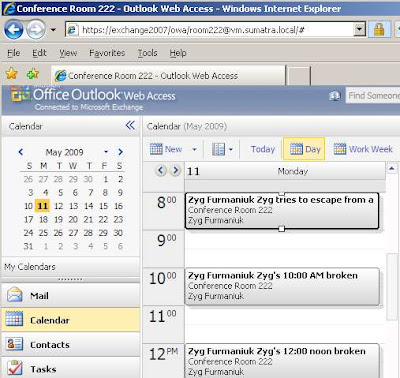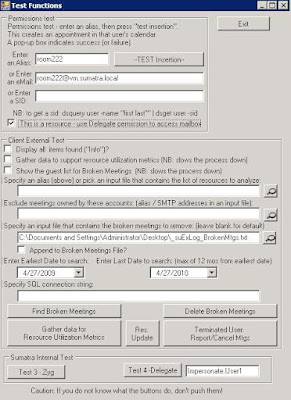This might seem a little esoteric, but it's still important.
Let's look at name changes in Exchange / Active Directory and how they have an impact on calendaring.
User Name Changes has done a good job of sketching out the mechanics of name changes and its repercussions for email. However, as with anything else there's some consequences for calendars that we feel the need to document.
So let's look at Marge Bouvier and her calendar in Exchange 2007.


In the way of many marriages, Marge changes her name to Simpson after marrying her high school sweetheart, Orenthal.

If we change her name (leaving her alias alone) and go back into her calendar we note that the display name at the top is "Marge Simpson." New meetings are created as "Marge Simpson" but previously created meetings are still labeled "Marge Bouvier."

What happens when previously existing meetings are modified?
So glad you asked.
In her GUESTs' calendars (for example Russ) the original meeting looks like this:

If Marge updates it (say by adding an agenda), the invitation comes into Russ's inbox looking like it's from Marge Simpson:

But accepting it and looking at it in Russ's calendar, it will STILL identify the organizer as "Bouvier."

SO NOW, let's look at it the other way: When the organizer modifies a meeting Marge is a guest in.
Say, Russ modifies his original meeting:

Like this:

MARGE sees the following update come into her inbox (identifying her as Marge Simpson):

And now this exception is listed in Russ's calendar as having Marge Simpson as a guest.
Confused?
If you're not confused you haven't been paying close attention.
The situation is at least comprehensible because updates are at least still going between Marge and everybody else in the organization. What makes this possible is that her Alias ("marge") remained constant. Meetings which are unchanged keep her as "Marge Bouvier" meetings which are new or get updated list her as "Marge Simpson" (most of the time).
If her alias started as "marge.bouvier" and it needed to morph to "marge.simpson" things would be a lot wilder and woollier with all previous meetings now invalid and updates being impossible (exactly as happens with email in this situation).
I leave as an exercise to the interested reader what happens to any Delegate rights Marge had set up prior to her name change.





 Open it and highlight the emails, copy / drag them into "Guests"
Open it and highlight the emails, copy / drag them into "Guests"
 SAVE it and SEND it:
SAVE it and SEND it: Voila, live meetings, simple, inexpensive, and done.
Voila, live meetings, simple, inexpensive, and done.

 Of course, I got THIS one at 3:43 PM PDT which was DARNED confusing:
Of course, I got THIS one at 3:43 PM PDT which was DARNED confusing: So with everyone who's been looking to migrate into Google Calendar: be really careful what you ask for.
So with everyone who's been looking to migrate into Google Calendar: be really careful what you ask for.





 In an example of instant karma, the test site told us of a wonderfully simple short cut to permissions in setting up insertion (for those of you who have not been through a migration) based on BlackBerry Enterprise Server permissions, which we'll blog on separately.
In an example of instant karma, the test site told us of a wonderfully simple short cut to permissions in setting up insertion (for those of you who have not been through a migration) based on BlackBerry Enterprise Server permissions, which we'll blog on separately. Using our standard export tool on the OCS side, UNICPOUTU, this exports as:
Using our standard export tool on the OCS side, UNICPOUTU, this exports as: And will insert into Exchange just as you see.
And will insert into Exchange just as you see.  So in case we need to do Japanese or some other non-European character set we'll be able to respond.
So in case we need to do Japanese or some other non-European character set we'll be able to respond.  You'll notice that any of the recurrence pattern syntax is absent, as is any concept of the meeting ATTENDEES. Yes, you can take this and you can insert it as is into Exchange or any other calendar system that reads iCalendar. BUT without recurrences, attendees (and therefore attendee response status) and with no connection to managed conference rooms or resources.
You'll notice that any of the recurrence pattern syntax is absent, as is any concept of the meeting ATTENDEES. Yes, you can take this and you can insert it as is into Exchange or any other calendar system that reads iCalendar. BUT without recurrences, attendees (and therefore attendee response status) and with no connection to managed conference rooms or resources. It is CRUCIALLY better because while we are (still) lacking the recurrence patterns (don't worry, we re-create those), we have the attendee list and the attendee responses! This means we can re-create the full state of the meeting and make it live in Exchange. This also allows us to re-create the status in conference rooms.
It is CRUCIALLY better because while we are (still) lacking the recurrence patterns (don't worry, we re-create those), we have the attendee list and the attendee responses! This means we can re-create the full state of the meeting and make it live in Exchange. This also allows us to re-create the status in conference rooms.
 In the way of many marriages, Marge changes her name to Simpson after marrying her high school sweetheart, Orenthal.
In the way of many marriages, Marge changes her name to Simpson after marrying her high school sweetheart, Orenthal. If we change her name (leaving her alias alone) and go back into her calendar we note that the display name at the top is "Marge Simpson." New meetings are created as "Marge Simpson" but previously created meetings are still labeled "Marge Bouvier."
If we change her name (leaving her alias alone) and go back into her calendar we note that the display name at the top is "Marge Simpson." New meetings are created as "Marge Simpson" but previously created meetings are still labeled "Marge Bouvier."
 If Marge updates it (say by adding an agenda), the invitation comes into Russ's inbox looking like it's from Marge Simpson:
If Marge updates it (say by adding an agenda), the invitation comes into Russ's inbox looking like it's from Marge Simpson:
 SO NOW, let's look at it the other way: When the organizer modifies a meeting Marge is a guest in.
SO NOW, let's look at it the other way: When the organizer modifies a meeting Marge is a guest in.
 MARGE sees the following update come into her inbox (identifying her as Marge Simpson):
MARGE sees the following update come into her inbox (identifying her as Marge Simpson):










 How do we have the audacity to call it "broken?"
How do we have the audacity to call it "broken?"


 Pressing "Delete Broken Meetings" will remove them and log that to a report.
Pressing "Delete Broken Meetings" will remove them and log that to a report.